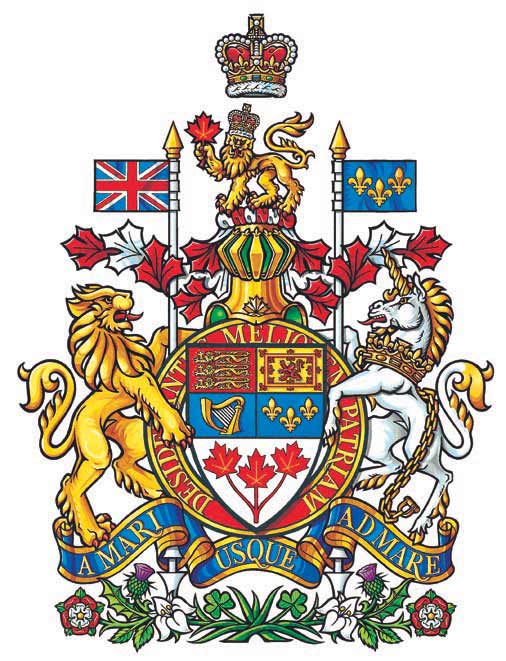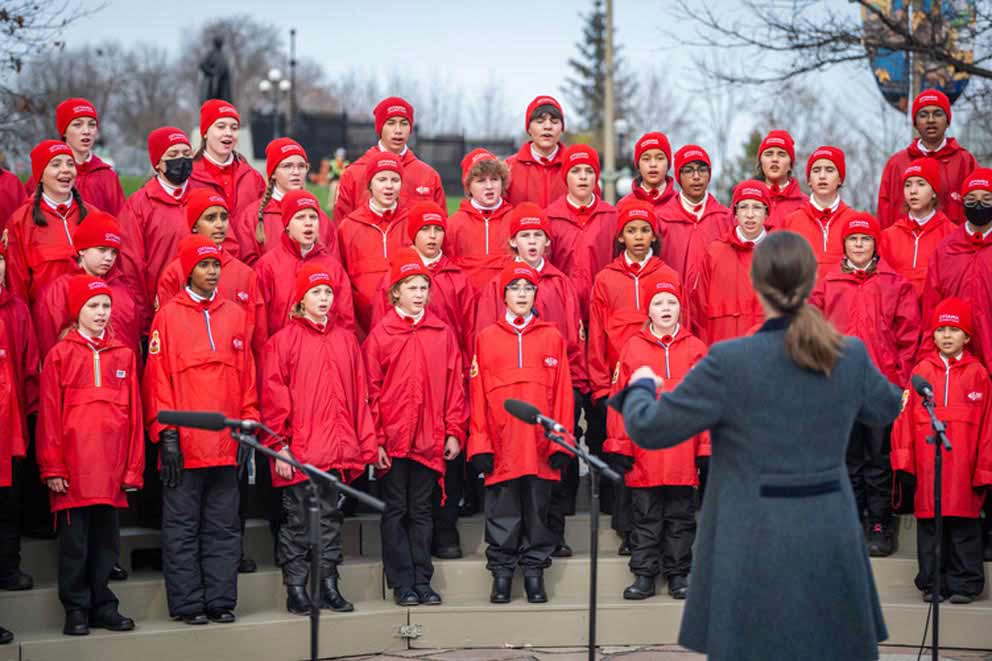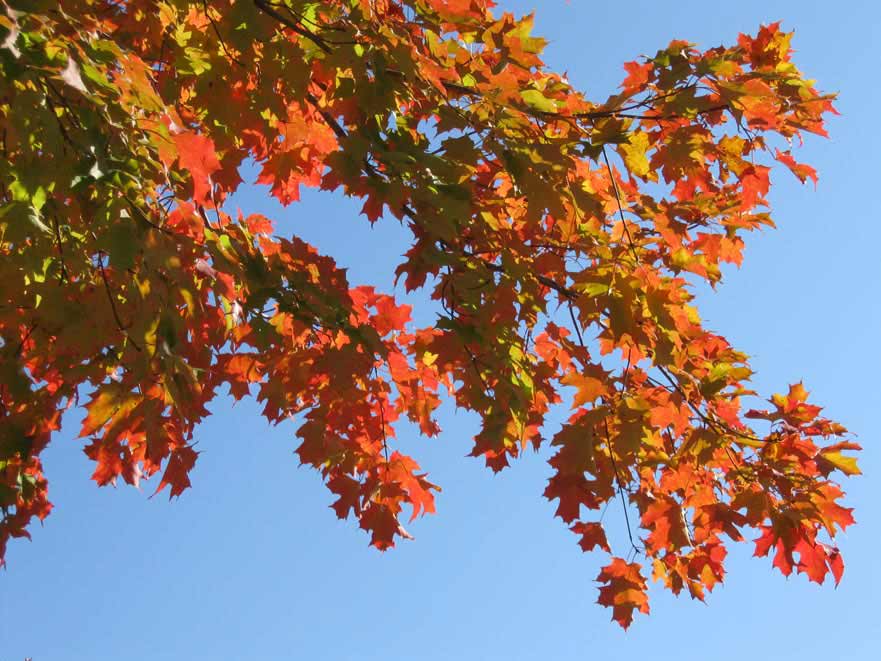Official symbols of Canada
Over the past century, the following symbols have become an integral part of our national identity through common use and collective pride, with most having been formally adopted by the Government of Canada as official symbols of our country.
On this page
- The Coat of Arms
- The national flag
- The beaver
- The national anthem
- Lacrosse
- Hockey
- The maple tree
- The national horse
- The Maple Leaf Tartan
- The national colours
The Coat of Arms

Source: Government of Canada
The Coat of Arms of Canada, called the Arms of Canada or the Royal Arms of Canada, were adopted by proclamation of King George V in 1921.
The use of coats of arms originated in Europe in the medieval period. The first coats of arms served to distinguish combatants on the battlefield. They were quickly adopted throughout all facets of society to identify individuals or other legal entities, such as organizations, municipalities, regions, and countries. The practice of heraldry, which we call the field of study and creation of coats of arms and other related emblems, continues to this day. Coats of arms still serve to create visual “identity cards” that represent their bearers. They are especially found in official contexts, as is the case for the arms of sovereign countries.
The Coat of Arms of Canada display the royal emblems of England, Scotland, Ireland, and France, while also featuring distinctly Canadian symbols.
The Royal Crown that sits atop the Coat of Arms indicates that these are the Arms of His Majesty the King in Right of Canada.
Canada’s motto is A Mari Usque Ad Mare, which translates to “From Sea to Sea”.
In 1994, a circular, red ribbon was added to the Arms, displaying the motto of the Order of Canada: Desiderantes Meliorem Patriam (meaning “They desire a better country”).
The present artistic rendering of the Arms of Canada was drawn by Cathy Bursey-Sabourin, Fraser Herald at the Canadian Heraldic Authority.
Did you know?
Canada’s provinces and territories also have their own distinct coats of arms, many of which incorporate Indigenous emblems. For example, this is the case with the coat of arms of Prince Edward Island, which features the 8-pointed star of the Mi’kmaq people, of New Brunswick with the wampum of the Wolastoqiyik (Maliseet) Nation, and of Nunavut which features, among other symbols, the inukshuk and the qulliq.
The national flag

Source: Government of Canada
The National Flag of Canada was adopted on January 28, 1965, by proclamation of Queen Elizabeth IIFootnote 1. On February 15 of that same year, the new National Flag of Canada was raised for the first time on Parliament Hill.
Every year, on February 15, the entire country celebrates National Flag of Canada Day to highlight this anniversary.
The design of the National Flag of Canada is the result of an intensive creative process that took place in 1964. With its distinctive maple leaf, Canada’s red and white flag is easily recognized around the globe.
Learn more about the National Flag of Canada, including its history, dimensions, flag etiquette and rules for half-masting.
Did You Know?
The creation of the National Flag of Canada is the work of many people who contributed to the project during the 1960s, from its first concept to the final design. Discover some of the key individuals!
The beaver

Source: iStock.com/Randy Alexander
The beaver is a herbivorous mammal that makes its home in semi-aquatic environments throughout every region in Canada, especially near waterways, lakes, and ponds. It became an official symbol of Canada on March 24, 1975, when the National Symbol of Canada Act received royal assent. This law aimed to showcase the beaver (castor canadensis) as one of the symbols of Canadian sovereignty.
The beaver had already been a part of Canadian identity before the Act was adopted. For example, in 1851 the beaver was featured prominently on Canada’s first postage stamp. It was also seen on the totem poles of First Nations on the Pacific coast. In fact, the beaver was the first universally popular symbol of Canada, even before the maple leaf.
Long before the arrival of European settlers, Indigenous peoples recognized the importance and value of the beaver. Its fur was used to make clothing and its bones were used to make a variety of tools. Its nutritious meat also made it a valuable food source. Furthermore, a substance secreted by its glands served as excellent bait for other carnivorous species.
Despite these qualities, the reason the beaver became an official symbol of Canada is first and foremost the central role it played in the fur trade that stretched from the 17th to the middle of the 19th century. This period saw a heavy demand for beaver pelts, which were especially important in the manufacture of the waterproof felt hats that were very popular in Europe at the time. The beaver’s presence in North America represented a substantial commercial opportunity for Europeans and motivated the exploration and colonization that marked the history of Canada.
While the fur trade played an important role in Canada’s history, it was also responsible for the near extinction of the beaver as a species. Towards the middle of the 19th century, the beaver had almost disappeared from the Canadian landscape. Measures were put in place to protect it and, consequently, its populations have recovered throughout the country.
Did You Know?
The beaver is featured on many heraldic emblems in Canada. For example, it is found on the arms of the province of Manitoba and on the badge of the Huron-Wendat Nation.
The national anthem

Source: Sgt Mathieu St-Amour, Rideau Hall
“O Canada” was proclaimed Canada’s national anthem on July 1, 1980, with the adoption of the National Anthem Act.
“O Canada” was first performed a century earlier, on June 24, 1880, during the Saint-Jean-Baptiste Day celebrations in the City of Québec.
The music was composed by Calixa Lavallée, and the French lyrics were written by Adolphe-Basile Routhier. Many English versions have appeared over the years. The version on which the official English lyrics are based was written in 1908 by Robert Stanley Weir.
From its creation until it was adopted as our national anthem, “O Canada” served as an increasingly popular patriotic song, both in French- and English-speaking Canada. Today, it allows Canadians to honour their country with pride and enthusiasm.
Read the history of “O Canada”, learn about the people behind the anthem, listen to recordings or watch sign language versions of the national anthem and read the official lyrics.
Did You Know?
According to tradition and as a sign of respect, it is customary to stand when “O Canada” is played. The same etiquette also applies to the national anthems of other nations.
Lacrosse

Source: The Canada Games/Larry Mathewson
Lacrosse is a team sport where players try to score the most goals by throwing a rubber ball into the opposing team’s goal with the help of a stick fitted with a net on one end, allowing players to pass, catch, and throw the ball.Footnote 2 Lacrosse can be played on an indoor surface (box lacrosse), or outdoors on a grassy field (field lacrosse).
In 1994, a Member of Parliament presented a bill in the House of Commons proposing that hockey should be made Canada’s national sport. Following a debate, the bill was modified, and hockey was then declared Canada’s national winter sport, and lacrosse as the national summer sport. The National Sports of Canada Act was given royal assent on May 12, 1994.
The origins of contemporary lacrosse are to be found amongst First Nations of Turtle Island (that is, North America) who played stick ball games long before the arrival of the first European settlers. It is thus one of the oldest team games played on the American continent. In fact, the game is known under various names, notably Deyhontsigwa’ehs in Onondaga, Tewaaraton in Mohawk, or Baggataway amongst the Algonquin groups. While it is difficult to describe with any precision how the ancient game was played, with each Nation having its own traditional version of the game, matches could be played over several days and over large areas. In ancient times, as today, the game is considered by many Indigenous peoples as a medicine game, played in the Sky World and on Mother Earth, and a gift of the Creator that is still played to honor and respect the way of life and ceremonies of First Nations.
European settlers showed interest in lacrosse from their very first encounters with the game. In the mid-19th century, settlers began adapting the game and converted it into a sport, applying their own rules. The first sports organization in the Dominion, the Canadian Lacrosse Association, was created in 1867 under the leadership of George Beers, adopting the slogan “Our country, our game”. However, the traditional form of the game remained alive and well amongst First Nations. Then, many Indigenous nations tended to gravitate toward box lacrosse, which became the sport of choice in Canada.
In 1901, Lord Minto, Governor General of Canada, donated a silver cup to serve as a trophy for the senior amateur lacrosse championship in Canada. The Minto Cup, which is today awarded to the victors of the junior men’s championship, remains one of the most coveted prizes in the world of lacrosse. A similar trophy, the Mann Cup, is awarded for the senior men’s box lacrosse championship.
Today, lacrosse is played from coast to coast, as well as in several other countries, in four distinct disciplines: box lacrosse, field lacrosse, women’s lacrosse, and inter-crosse. Lacrosse will also make a return to the Olympic program, to be featured in the 2028 Summer Olympic Games, after having been absent since 1908.
Did you know?
In 1876, two Canadian teams (one from Kahnawake and the other from Montréal) competed at Windsor Castle, in England, in the presence of Queen Victoria. This was the second of three lacrosse tours in England, to showcase Canada as a nation.
Hockey

Source: WinSport
Ice hockey, commonly called hockey, is a team sport played on a frozen surface (skating rink). Each of the two teams, composed of 6 players, seeks to score the most goals by using curved sticks to send a rubber disc, known as a puck, into the opposing team’s goal, located at one end of the rink.
The Parliament of Canada declared hockey as the national winter sport when the National Sports of Canada Act received royal assent on May 12, 1994. Hockey occupies a prominent place in Canadian history. Since its very beginnings, hockey has stood out as an important element of our identity, acting as a unifying force. As the sport of hockey gradually developed, Canada contributed to its rule structure, its development, and its expansion, and left its mark on the international scene thanks to the skill of its teams.
Hockey’s diverse origins have been the object of much debate. However, Canada played a key role in the adoption of the sport’s modern version. In the late 19th and early 20th centuries, Canadian rules, such as the use of a rubber puck rather than a ball, gradually became the standard in hockey. In 1911, the national Hockey Association, a Canadian organization and predecessor to today’s National Hockey League, reduced the number of a team’s players on the ice from 7 to 6. Other leagues would also adopt this rule in the following decade.
Lord Stanley, Governor General of Canada from 1888 to 1893, also contributed to the development of hockey as the organized sporting institution we know today. In 1893, Lord Stanley decided to offer a trophy to the best ice hockey team in the country. In 1927, the National Hockey League adopted the Stanley Cup as the trophy awarded to the team that emerged as playoff champion.
Throughout history, Canada has won some important international competitions that have united Canadians and inspired national pride. These include the World Junior Championships, the Hockey World Cup, Olympic and Paralympic Games, and the memorable Canada-U.S.S.R. Summit Series in 1972, known as the Series of the Century, which resonates as one of the greatest moments in the history of Canadian sports.
As the game of hockey developed, women’s hockey and para hockey (formerly known as sled or sledge hockey) also appeared and rapidly grew to prominence both in Canada and worldwide. Since the introduction of women’s hockey at the Olympic Games in Nagano in 1998, the Canadian women’s team has won an impressive number of medals. Canada’s para hockey team, meanwhile, has competed in every iteration of the Paralympic Games since the sport was introduced in 1994, earning many medals.
Today, hockey and para hockey are played by hundreds of thousands of Canadians of all genders and ages, demonstrating that Canadians’ passion for this sport is alive and well across all regions of the country.
Did You Know?
In 1956, Canada Post issued its first hockey-themed stamp to draw attention to Canada's most popular winter sport. This 5 cents postage stamp paid tribute to Canada's hockey players, their skills, and the recognition they earned in international competitions.
The maple tree

Source: Government of Canada
Although the maple is closely associated with Canada, the Proclamation Designating the Maple Tree as National Arboreal Emblem of Canada was only adopted in 1996.
Of the 150 known species of maple (genus Acer), 10 are native to Canada: the sugar, black, bigleaf, silver, red, mountain, striped, Douglas, vine and Manitoba maples. While the sugar maple is probably the most well-known of the maple species, Canada’s arboreal emblem is the generic maple species.
The maple has played a meaningful role in the development of Canada on a commercial and ecological level, and even in terms of our identity, when thinking of the maple leaf and the important emblem it has become. Indigenous peoples were the first to recognize the maple’s value and benefits. Long before the arrival of the first settlers, Indigenous peoples were using the maple for its medicinal properties and to make tools and objects such as traps. They collected its sap, which they rendered into syrup and sugar, and used it to smoke meat for prolonged conservation. They would later share their knowledge with the newcomers, who, over time, adapted these methods to increase production in the face of an ever-increasing demand for maple products both in North America and Europe.
Today, the maple industry continues to create jobs, especially in rural areas, and generates economic benefits through the export of maple products to about 60 countries throughout the world.
Did You Know?
Canada is the largest producer and exporter of maple products in the world. While several Canadian provinces produce maple products, the vast majority of production and export comes from Quebec.
The national horse

Source: Photo Sport JFX
While the Canadian horse had been a feature of Canada’s agricultural and industrial landscape for centuries, it was not until April 2002 that it was recognized as the national horse of Canada by the National Horse of Canada Act.
The origins of the Canadian horse date back to 1665. At that time, the King of France, Louis XIV, sent some of the best mares and stallions from the royal stables to New France – the Norman and Breton horses were of mixed origin and included Arabian, Barb and Andalusian horses. Over the next century, amidst harsh winters and tough working conditions on the land, the horse population of New France developed in isolation from other breeds and acclimatized to Canadian conditions, gradually becoming a breed of its own – the Canadian horse.
Known for its great strength, endurance, intelligence, and good temper, the Canadian horse is very versatile despite its small size. Also called “the little iron horse”, it worked side by side with the early settlers to help build the country. From farm work, to logging and trail riding, the dark-coated Canadian horse impacted agriculture, trade and transportation in Canada’s early modern history. It was also exported, notably serving as artillery and cavalry horses in the American Civil War.
Threatened with extinction in the late 19th century, efforts were made in the late 1800s and throughout the 20th century to preserve the distinctive Canadian horse. Today, although still at risk, they number in the thousands and can be found across the country.
Did you know?
In 1999, the Canadian horse was designated a heritage breed by the Parliament of Quebec, as it is closely associated with the historical origins and agricultural traditions of the province. The Act Respecting Animal Breeds Forming Part of Québec’s Agricultural Heritage also declared the Canadian cow and the Chantecler chicken as heritage animal breeds in Quebec.
The Maple Leaf Tartan

Source: The Royal Canadian Regiment (photographer unknown)
The Maple Leaf Tartan was declared an official national symbol on March 9, 2011, by way of a ministerial declaration.
Tartan is a cloth, often made of wool or cashmere, that is characterized by its pattern of horizontal and vertical lines crossing at right angles, showcasing various colours. Tartans are generally associated with Scotland and its various regions, clans, and families. Today, tartans are often used to express membership in a family or an organization.
Created in 1964 by David Weiser, a Toronto businessman working in the fashion industry, the Maple Leaf Tartan was designed in anticipation of the 100th anniversary of Confederation in 1967. Inspired by the colours of the maple leaf through the changing seasons, the tartan’s pattern incorporates the green of summer leaves, the gold of early autumn, the red of the first frost and the brown tones of fallen leaves before winter. The symbolism of the Maple Leaf Tartan thus highlights a distinct aspect of the Canadian landscape. Its name is also inspired by another symbol that emerged in the mid-1960s: the National Flag of Canada, which features a stylized maple leaf.
On October 21, 2010, the Government of Canada declared that April 6 would be known as Tartan Day. Tartan Day celebrations include parades by pipe bands, traditional dance, often inspired by Scottish culture, as well as community gatherings.
A symbol of national pride, the tartan was designed to be worn by Canadians from all backgrounds, especially on days like Canada Day (July 1) and Tartan Day (April 6).
Did You Know?
Many items of clothing bearing the pattern of the Maple Leaf Tartan were sold on the grounds of Expo 67, an event marking Canada’s Centennial in 1967.
The national colours

Source: Government of Canada
It was long believed that red and white were designated as Canada’s national colours by King George V in the proclamation of the Canada Coat of Arms in 1921. However, the proclamation contains no such declarationFootnote 3Footnote 4.
Notwithstanding this popular historical misconception, red and white, the colours that adorn the National Flag of Canada, have undeniably come to represent Canada both at home and abroad. It is in fact common practice throughout the world for a country’s national colours to be those featured on its national flag.
Many Canadians have also come to embrace these colours as representative of natural features prominent in some parts of our country: the white of winter snows, and the red of autumnal maple leaves.
Over time, red and white have become an integral part of our national identity, through common use and collective pride, even if they are not enshrined in law as national colours.
Did You Know?
The National Flag of Canada is subject to manufacturing standards that include, among others, the precise colour parameters of the red to be used. Many factors must be considered in order to respect the proper shade of red for the flag, including the material or surface on which the flag design is to be printed.
Page details
- Date modified: